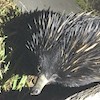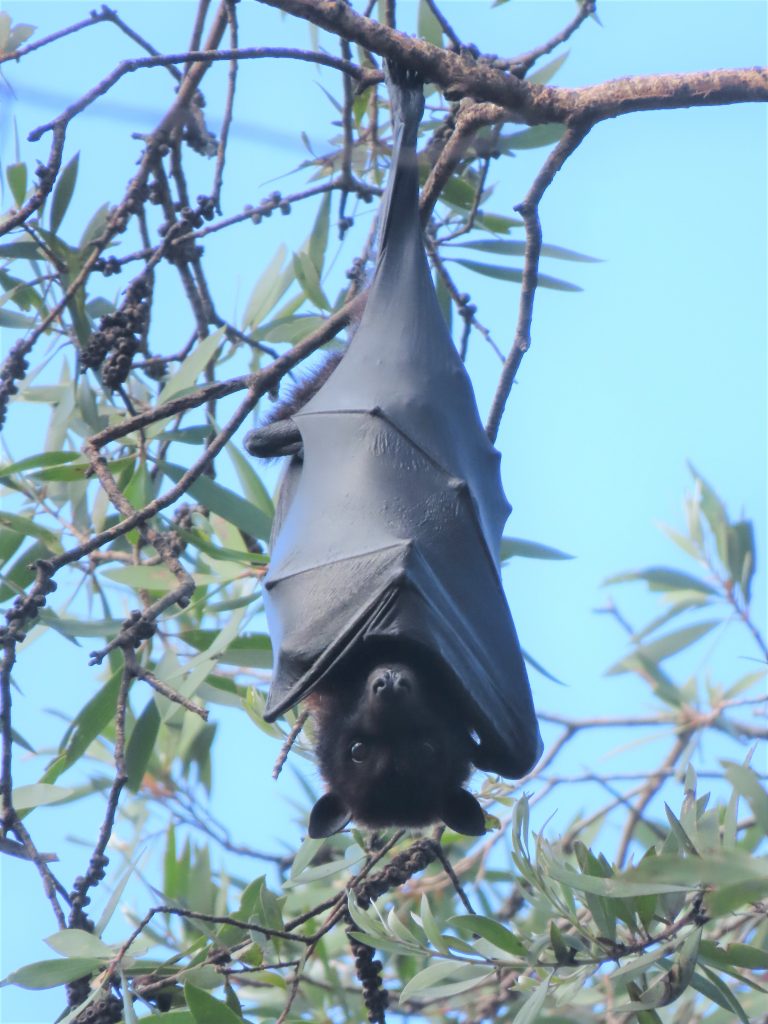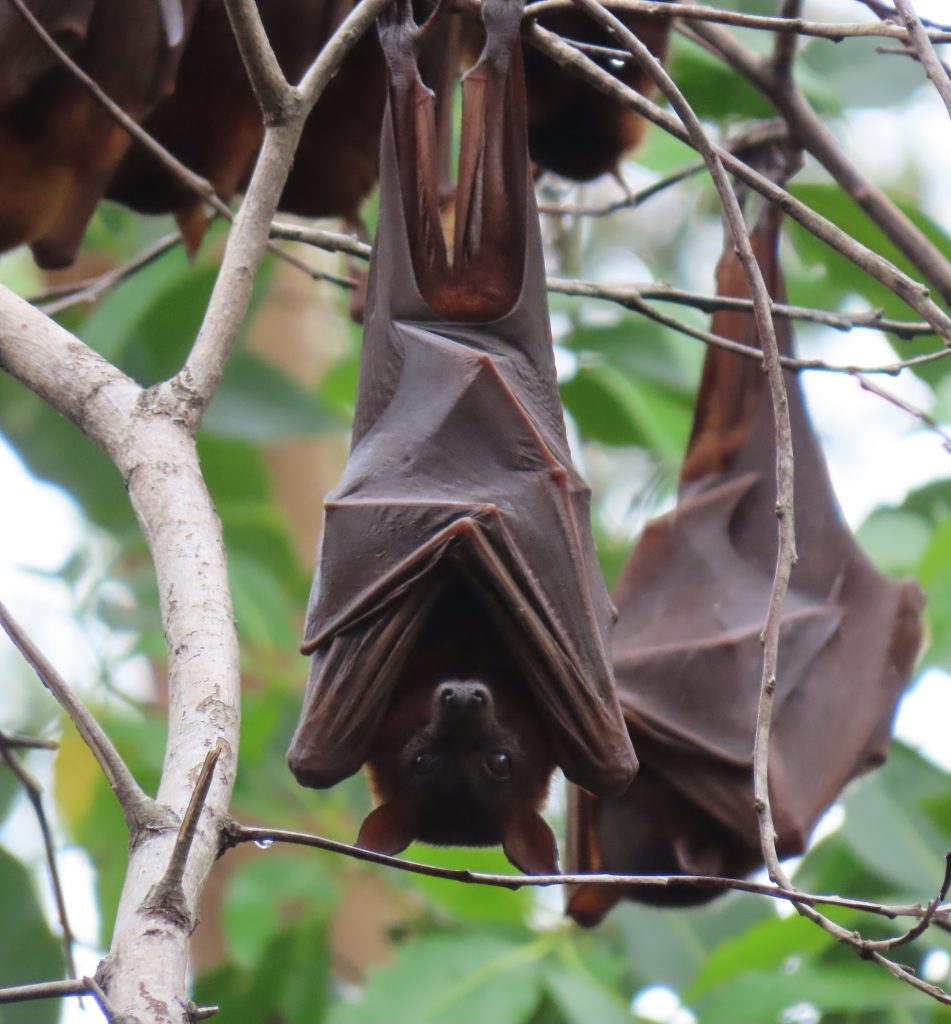MAMMALS FOUND IN THE MOGGILL CREEK CATCHMENT
This listing was created by Ed Frazer, an MCCG member and prolific local wildlife photographer.
Supporting photos were taken within the Moggill Creek Catchment. They are the copyright of the person noted beneath each image. Many photographers are MCCG members.
We encourage MCCG members and non-members alike to submit photos taken locally of the listed species for inclusion. Please send your images to: [email protected]
The table has two categories:
1. Native mammals
2. Feral mammals – the Moggill Creek Catchment has some of the most serious feral animal problems in Brisbane, particularly cats, deer, foxes and dogs.
Sightings should be reported ASAP to the Brisbane City Council. Click here to open the online BCC Report-it form.
| 1. NATIVE MAMMALS |
||||
| Species name (Common name in brackets) |
Similar species found | Food | Notes | |
 © Ed Frazer  © Chris Read |
Antechinus, Brown | Other Antechinus spp. | Insects Worms |
Four similar species in the catchment. Look similar to mice and occasionally enter houses.
Their teeth are quite sharp and they can be aggressive. The one in the photo had entered a house adjacent to ridge-line bush. They are more active after dark and are threatened by cats. |
 © Ed Frazer |
Antechinus, Buff-footed (identification not confirmed) |
Other Antechinus spp. | Insects Worms |
The recently described Buff-footed Antechinus has an even grey body colour, similar to the Brown Antechinus.
It has a light eye-ring which is absent on the Brown Antechinus. The Buff-footed Antechinus differs from the Fawn-footed Antechinus which always has a pronounced rufous mid-body colour and a whitish eye ring. This one was startled out of a crevice in a tree by a White-throated Treecreeper. Threatened by cats and habitat destruction. |
 © Ed Frazer  © Bryan Hacker |
Antechinus, Fawn-footed | Other Antechinus spp. | Insects Worms |
This Antechinus came out in the early morning to take mealworms which were being fed to Painted Button-quail.
Found mainly in areas along creeks. Threatened by cats. |
 © Beck Bain  © Beck Bain |
Antechinus, Yellow-footed | Other Antechinus spp. | Insects Worms |
This species favours woodland areas with large diameter trees.
It takes insects from crevices in the bark at night, but it also forages in the leaf litter. It is widely distributed along the East coast of Australia from Queensland to South Australia. These photos were taken along the Araucaria track at Brisbane Forest Park/D’Aguilar National Park |
 © Ed Frazer Camera trap  © Gordon Grigg Camera trap |
Bandicoot, Long-nosed | Northern Brown Bandicoot | Insects Grubs Roots |
Digs holes in lawns and gardens searching for grubs and roots.
Difficult to distinguish from the Northern Bandicoot which has a similarly long nose. Has coarser fur and more rounded ears. Threatened by cats, dogs and foxes. |
 © Ed Frazer Camera trap |
Bandicoot, Northern | Long-nosed Bandicoot | Insects Grubs Roots |
Not as common in gardens. Prefers wetter gullies and areas alongside creeks.
Has pointed ears and finer fur than the Long-nosed Bandicoot. |
 © Ed Frazer  © Ed Frazer Camera trap |
Brush-tailed Phascogale (Tuan) |
None | Insects Small birds Small mammals |
Notorious for entering chicken pens and throttling birds which are bigger than itself.
Related to the Antechinus and to the Tasmanian Devil, the Tuan is strictly carnivorous. Was once common in the catchment but is now seldom seen. Threatened by cats, dogs and urbanisation. |
 © Ed Frazer Camera trap |
Dingo | Domestic dogs | Small mammals Lizards |
Most dingoes in the catchment probably have some domestic dog inter-breeding but several have been photographed in the area using infra-red triggered cameras. They appear to have mainly Dingo features. |
 © Ruby Cooper-White  © Gordon Grigg Camera trap |
Echidna | None | Ants Termites Small grubs Worms |
There are many echidnas in the catchment present along the creeks and right up to the tops of the valley ridges. They are rarely seen during daylight hours.
Threatened by habitat destruction and dogs. |
 © Ed Frazer Camera trap  © Ed Frazer Camera trap |
Fawn-footed Melomys | Mice and small rats | Probably vegetable matter | Found around the creeks where they search for insects in the leaf litter.
Quite common along Gold Creek. Nocturnal and feed mainly on the ground but they also climb trees. A little bigger than a mouse, the tail of the Melomys is almost hairless. Threatened by cats and preyed upon by owls. |
 © Jim Pope (taken at Toowong) |
Grey-headed Flying Fox (Fruit Bat) | Black and Small Red fruit bats | Figs Mangos Other fruit Also feed on Eucalyptus blossom |
Probably come from colonies roosting along the Brisbane River.
Known to sometimes carry the fatal Lyssavirus (related to rabies) so avoid handling. Weigh up to 1kg with a wingspan of 1m. Numbers have reduced due to tree clearing. |
 © Rebecca Bain © Rebecca Bain |
Black Flying Fox (Fruit Bat) | Grey-headed and Little Red Flying Foxes | Figs and other fruit; nectar | Flying Foxes are important pollinators and spreaders of seeds in the rainforest.
Some Flying Foxes are known to carry Australian Bat Lyssavirus, which can be fatal, so they should not be handled. |
 © Rebecca Bain © Rebecca Bain |
Little Red Flying Fox (Fruit Bat) | Grey-headed and Black Flying Foxes | Figs and other fruit; nectar | Smallest of the Flying Foxes indigenous to Australia
Flying Foxes are important pollinators and spreaders of seeds in the rainforest. Some Flying Foxes are known to carry Australian Bat Lyssavirus, which can be fatal, so they should not be handled. |
 © Prue Cooper-White |
Glider, Greater | Possums | Eucalpyts New shoots Leaves |
Thought to be extinct in the catchment until Prue Cooper-White took this photo.
They are as large as a possum and feed entirely at night. This one was photographed during the daytime because it had been disturbed out of its hole by the Lace Monitor. Greater gliders occupy several large holes in trees. Due to the heavy removal of trees with hollows there is not much habitat left in the catchment for this glider species. White mahogany (Eucalyptus acmonoides) is one of the recognised trees in the catchment on which Greater gliders feed. They feed on the shoots. Preyed upon by Powerful Owls. |
 © Ed Frazer Camera trap  © Chris Read |
Glider, Squirrel | Sugar Glider | Sap from trees Insects |
Quite common in the catchment and a real treat to watch in the evening if they “fly” from their hiding place high in a tree during the daytime.
A favourite prey of the Powerful Owl and the Boobook Owl. Threatened by habitat destruction, especially old trees with suitable holes. |
 © Chris Read |
Glider, Sugar | Squirrel Glider | Sap from trees | Similar habitats to the Squirel Glider. Can be identified by white at the tip of its tail.
Less common in the catchment than the Squirrel Glider. Threatened by owls and habitat destruction. |
 © Chris Read |
Glider, Feathertail | Squirrel Glider (but much smaller) | Pollen Seed Nectar |
Much smaller than the Squirrel Glider.
Feathertail Gliders are the natural prey of Antechinus, Brush-tailed Pasocogale and owls. Threatened by cats and habitat destruction. * For more info and a great story about Feathertail Gliders, read Chris Read’s Bush Bites article: A Suprisingly tricky Feathertail Glider Release |
 © Ed Frazer |
Koala | None | Main food trees in the catchment are: Grey Gum – Eucalyptus major Tallowood – E. microcorys Small-fruited Grey Gum – E. propinqua |
There are a few koalas in the catchment but they are seldom seen.
Domestic dogs and clearing have been the main cause of their heavily reduced numbers in the catchment. Planting their favourite trees such as Grey Gums may help. Koala scratches on Grey Gums are generally two parallel marks, much |
 © Chris Read |
Microbats | A number of species found in the catchment |
Mainly insects, including moths and mosquitos | Roost in dark crevices either singly or in groups.
Main threat is habitat destruction. |
 © Ed Frazer |
Platypus | None | Aquatic worms Dragonfly larvae Yabbies etc sifted out from the mulm at the bottom of the creek |
Mainly active in the morning but can be seen throughout the day in pools that are heavily shaded.
Threatened by creeks being allowed to dry out completely by the illegal use of water by unregistered pumping during droughts. Can be drowned in enclosed yabbie/crayfish traps such as Opera House traps, and eel traps. These traps are also a threat for water rats and fresh water turtles. * Since 2005 the MCCG has been running a platypus survey each September in partnership with the University of Queensland. This is completely volunteer-driven. To see more info, please click here. |
 © Alan Frazer  © Jim Pope |
Possum, Common Brushtail | Mountain Possum | New shoots from a wide variety of trees, fruit and berries |
Sit in the hollows of trees during the day and feed through the night.
Often come to the ground to find fallen fruit and berries. Enter houses regularly and are especially fond of apples and peanut butter! Varies in colour widely but those in the catchment generally have some tan colouration. Threatened by dogs and an ulcer-inducing disease known as Buruli Virus, a zoonotic virus which can affect people, also causing ulcers. |
 © Ed Frazer Camera trap  © Ed Frazer  © Gordon Grigg Camera trap |
Possum, Mountain | Common Brushtail Possum | New shoots, fruit and berries Suspected of taking eggs and hatchlings from trees |
Similar to the Brushtail Possum but the Mountain Possum has smaller, more rounded ears and is always grey or black on the back, and white underneath.
Threatened by dogs. |
 © Ed Frazer Camera trap |
Possum, Ringtail | Mountain Possum Common Brushtail Possum |
New shoots and flowers | Easily separated from the two Brushtail Possums by its very short-haired tail which it can use for gripping branches.
Threatened by dogs. |
 © Ed Frazer Camera trap |
Red-necked Pademelon | Young wallabies | Grasses on the edge of Lantana or thick scrub | Very shy animal that uses the protection of the Lantana or scrub from which it rarely ventures.
It is usually single and when disturbed makes a single loud “thump” with its tail and disappears into the thickest part of available bushes. Almost impossible to see during daylight hours and photographed only by using infra-red triggered cameras. Threatened by dogs and urbanisation. * To learn more, take a look at Ed Frazer’s Bush Bites article: Red-necked Pademelons are here |
 © Ed Frazer  © Ed Frazer  Mother & joey © Ed Frazer |
Wallaby, Red-necked | Swamp wallaby | Grasses Some broad-leaved weeds |
The most common wallaby in the catchment.
Often seen in the day in small family groups of females or single males. Swamp wallabies feed both in the early morning and evenings, continuing through the night. Threatened by dogs and habitat destruction. * For more info about wallabies in our catchment (and some great photos), read Ed Frazer’s Bush Bites article: Which Wallaby? |
 © Ed Frazer Camera trap  © Gordon Grigg |
Wallaby, Swamp | Red-necked wallaby | Herbs Fungi Grasses |
Usually found singly, and often a female carrying a joey.
Generally found in deep scrub, venturing out at night. Feed at night almost entirely. Threatened mostly by habitat destruction and dogs. |
 © Ed Frazer Camera trap |
Water Rat | None | Snails Fish Insects Yabbies Frogs Even get into chook sheds! |
Quite a large rodent which can grow to the size of a cat. Has a very obvious white tip to its tail.
A savage carnivore which lives in holes in creek banks. Common in the catchment but seldom seen as it goes about its destruction at night. Threatened by habitat destruction and possibly cats. |
2. FERAL MAMMALS |
||||
| Name | Similar species found | Food | Notes | |
 © Ed Frazer Camera trap  © Ed Frazer Camera trap |
Cat | None | Birds Mammals Lizards |
Cats are by far the most serious feral pest in the catchment. Between 2013 and 2017 Brisbane City Council caught nearly 4000 feral animals. 80% of these were cats.
There are large numbers of feral cats which should be trapped and destroyed but, additionally, many well fed, obviously domesticated cats are also photographed hunting at night via infra-red cameras. They kill lizards, frogs, birds and many small marsupials. Domesticated cats should never be allowed to roam at night. |
 © Ed Frazer  © Ed Frazer  © Ed Frazer |
Deer, Fallow | Red deer Rusa deer |
Tree shoots Herbs and grasses |
Fallow deer are the most common deer in the catchment. They can be recognised by white spots on their body, a white rear end and the palmate form of their antlers.
They damage many young trees and the bark of larger shrubs. Brisbane City Council is actively reducing their numbers as they are creating a traffic hazard. |
 © Ed Frazer  © Ed Frazer Camera trap |
Deer, Rusa | Fallow deer Red deer |
Tree shoots Herbs and grasses |
Larger than the Fallow Deer and usually grey or brown. Males have separate spikes on their antlers.
Some completely white Rusa deer have been seen in the catchment. It has been suggested that these deer are carriers of a Lymes-like disease which is spread by ticks. |
 © Ed Frazer Camera trap |
Dog | Dingo | Animals Birds Carrion |
Several domestic dogs have been photographed at night by the infra-red cameras.
Some are heavily infected with mange whilst others look like domestic pets. Whilst not as destructive as cats, feral dogs do take some wildlife and pose a risk of transferring disease and parasites to domestic pets. |
 © Ed Frazer Camera trap  © Ed Frazer |
Fox | Dingo Domestic dog |
Birds Small mammals |
Foxes are second to cats in the damage they cause in the catchment. They regularly kill large numbers of fowl, but only take one to eat.
The fox illustrated was photographed via infra-red camera as it took a bandicoot. The fox in the trap came back for a second feed on one of the birds it had killed previously. Foxes are particularly ruthless predators of the rare ground breeding birds we have in the catchment. |
 © Ed Frazer  © Ed Frazer |
Hare | None | Grass Some herbs Garden vegetables |
There are huge numbers of hare in the catchment. On nearly every grassed area you will see their round, marble-sized droppings.
They feed in the early mornings and late into the night. |

